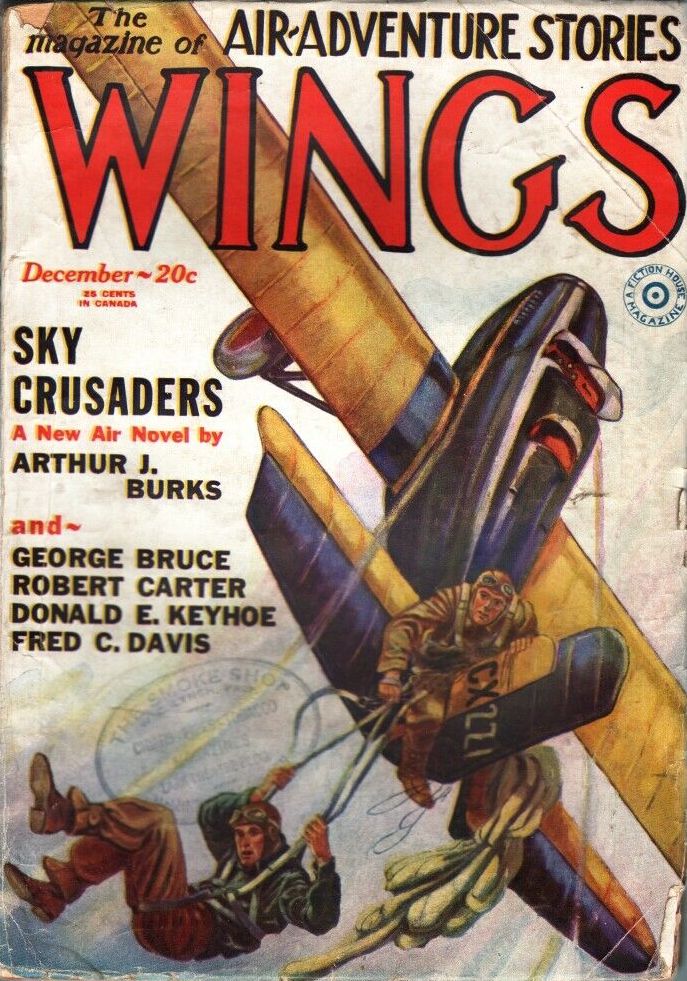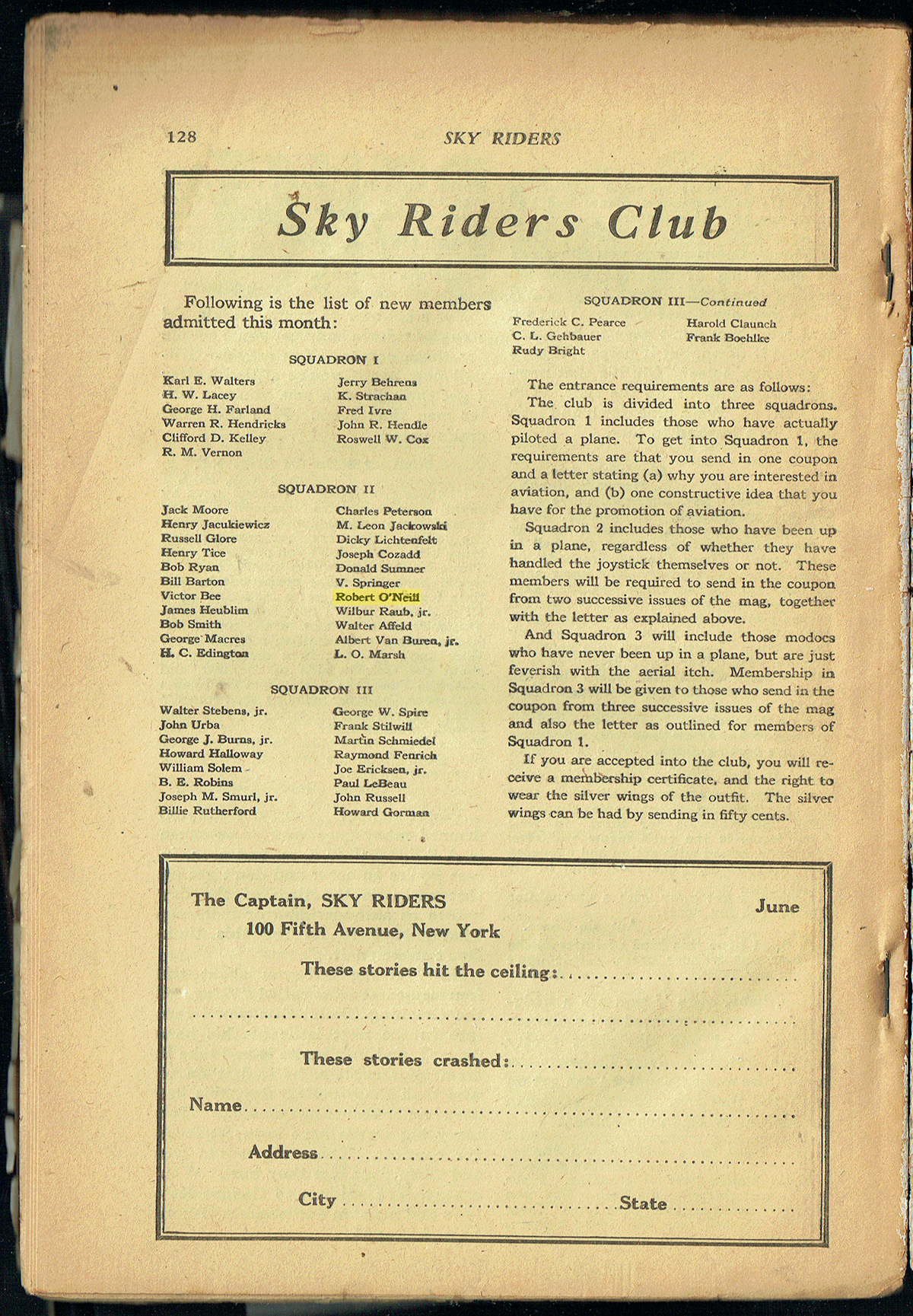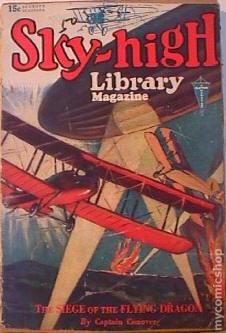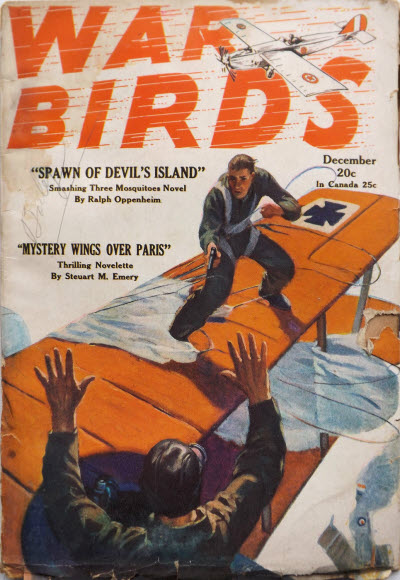“Fortune Flyers” by Robert Carter
THIS week we have a  exciting air adventure from the pen of Robert Carter. Carter was a decorated WWI aviator who flew Bristol Fighters along the Italian front and poured this experience into the pulp stories he wrote from 1927 to 1929 for magazines like Aces, Air Trails, Air Stories, Battle Stories, War Birds and Wings.
exciting air adventure from the pen of Robert Carter. Carter was a decorated WWI aviator who flew Bristol Fighters along the Italian front and poured this experience into the pulp stories he wrote from 1927 to 1929 for magazines like Aces, Air Trails, Air Stories, Battle Stories, War Birds and Wings.
When Webb Foster sacrifices his new plane to save a man in trouble, a wealthy Mr. Charlton hires him on to pilot his new plane on his expedition to Biplane Island to find a fortune in gold! From the December 1929 Wings, it’s Robert Carter’s “Fortune Flyers!”
Treasure waits under tropic seas. High in the skies above the Spanish Main, Webb Foster peers down upon coral reefs. And buccaneers of the air fly to do murder for hidden gold. . . .
- Download “Fortune Flyers” (December 1929, Wings)
As a bonus, here’s a brief biographical sketch of Carter from Air Trails’ November 1929 “Landing Field” Column:
 THIS month we’ve dragged another one of Air Trails’ pilot-writers out of his cockpit so that you folks can take a look at him. It’s hard to get these flying fellows to pose for their pictures. Most of them are so darned camera shy that you have to chase them all over the sky and shoot their props off before they’ll come down and act sensible. But sometimes you can catch them off guard.
THIS month we’ve dragged another one of Air Trails’ pilot-writers out of his cockpit so that you folks can take a look at him. It’s hard to get these flying fellows to pose for their pictures. Most of them are so darned camera shy that you have to chase them all over the sky and shoot their props off before they’ll come down and act sensible. But sometimes you can catch them off guard.
We got Robert Carter out to lunch the other day and said: “How about telling the folks something about yourself?” This was the fiftieth time we’d asked him the same question; but each time before he’d stalled us. Most pilots can stall just like a motor with a bug in the gas lines. But this time Carter sort of grinned and said he’d see about it. He’d just come back from a flight out to meet one of the big transatlantic liners. He’d flown in and around and over a fog bank as big as all outdoors, and for once his motor was working in good shape. He didn’t stall.
The very next day he sent us a slip of paper about two by three inches in size with a few details of his life written on it. It wasn’t much, but it was something. He also enclosed a picture of himself in a service uniform. Our staff artist made a line drawing of it.
Robert Carter is a Southerner by birth, and a Georgia Tech graduate. We want to say here that that’s a good start for any man. We’ve seen the Georgia Tech football team in action. They don’t make ‘em any better than you’ll find ‘em down where the Georgia peaches grow.
When the World War started it didn’t take Robert Carter long to get in it. He flew a Bristol Fighter on the Italian front—a tricky little two-place ship, death on landing, and powered with a water-cooled motor. He taught a good many Italians how to fly. Then he got into the thick of the fighting, was shot down once and received some painful wounds during a night bombardment.
At the end of the war Carter came home with a limp, ten dollars in his pocket, and a decoration. He has fifteen hundred air hours logged and certified too. Carter is a regular fellow. He tried to forget his war experience; but no one would let him. Some bright editor insisted that he write air stories. He did, and there you are.
Like the other men who are writing for Air Trails, his stories ring true because he knows a joy stick from the clutch on a tin lizzie. He doesn’t need to take a ride in a carnival shoot-the-chutes to get air action and “atmosphere.”





 Like many in the late 20’s and early 30’s, Robert O’Neil was fascinated with aviation and as such, a large part of both volumes of his scrapbooks is taken up with a cataloging of the many different types of planes. But amongst all the planes and air race flyers and info on Aces are some surprising items.
Like many in the late 20’s and early 30’s, Robert O’Neil was fascinated with aviation and as such, a large part of both volumes of his scrapbooks is taken up with a cataloging of the many different types of planes. But amongst all the planes and air race flyers and info on Aces are some surprising items.


 The Sky Riders Club had been combined with those members of the short lived Flying Corp Cadets which had been formed by readers of the first and sadly only issue of Clayton Magazine’s Sky High Library published in February 1930. The increase in new memberships allowed them to drop the price of the silver wings pin from 50¢ to 25¢ (September, 1930)
The Sky Riders Club had been combined with those members of the short lived Flying Corp Cadets which had been formed by readers of the first and sadly only issue of Clayton Magazine’s Sky High Library published in February 1930. The increase in new memberships allowed them to drop the price of the silver wings pin from 50¢ to 25¢ (September, 1930)

 a short story by renowned pulp author Frederick C. Davis. Davis is probably best remembered for his work on Operator 5 where he penned the first 20 stories, as well as the Moon Man series for Ten Detective Aces and several other continuing series for various Popular Publications. He also wrote a number of aviation stories that appeared in Aces, Wings and Air Stories.
a short story by renowned pulp author Frederick C. Davis. Davis is probably best remembered for his work on Operator 5 where he penned the first 20 stories, as well as the Moon Man series for Ten Detective Aces and several other continuing series for various Popular Publications. He also wrote a number of aviation stories that appeared in Aces, Wings and Air Stories.  a story from the pen of Donald E. Keyhoe—in fact, I believe it is his first aviation story he had in the pulps! More soap opera than dashing wartime aviation thriller, Keyhoe tells the story of Harvey Masters, Dizzy Jim Boyd, and the girl unwittingly caught between them! The strangest part is that nobody ever suspected the truth about Dizzy Jim Boyd, though there was a lot of guessing when he first showed up at Western Airways Field, until the day when Harvey Masters came through and stopped for gas. . .
a story from the pen of Donald E. Keyhoe—in fact, I believe it is his first aviation story he had in the pulps! More soap opera than dashing wartime aviation thriller, Keyhoe tells the story of Harvey Masters, Dizzy Jim Boyd, and the girl unwittingly caught between them! The strangest part is that nobody ever suspected the truth about Dizzy Jim Boyd, though there was a lot of guessing when he first showed up at Western Airways Field, until the day when Harvey Masters came through and stopped for gas. . .  the second of three Three Mosquitoes stories we’re presenting this month. The Mosquitoes fame had spread to such an extent on the Western Front that the German high command had issued a general order to get them, alive or dead. To cool things down, our impetuous trio has been temporarily reassigned to the British East African front. While on patrol the trio is hit by a violent tropical storm and separated. Kirby finds himself swept out over the Indian Ocean. After a confrontation with a Zeppelin he tried to take with him, Kirby is forced to land on a scraggy rock in the middle of the ocean. Marooned. His only company the skeletons of the island’s previous visitors, until—it turns out he did bring down the zeppelin, unfortunately the german crew of said zeppelin find themselves marooned on the same rock! From the December 1st, 1929 number of War Birds, it’s The Three Mosquitoes vs the “Spawn of Devil’s Island!”
the second of three Three Mosquitoes stories we’re presenting this month. The Mosquitoes fame had spread to such an extent on the Western Front that the German high command had issued a general order to get them, alive or dead. To cool things down, our impetuous trio has been temporarily reassigned to the British East African front. While on patrol the trio is hit by a violent tropical storm and separated. Kirby finds himself swept out over the Indian Ocean. After a confrontation with a Zeppelin he tried to take with him, Kirby is forced to land on a scraggy rock in the middle of the ocean. Marooned. His only company the skeletons of the island’s previous visitors, until—it turns out he did bring down the zeppelin, unfortunately the german crew of said zeppelin find themselves marooned on the same rock! From the December 1st, 1929 number of War Birds, it’s The Three Mosquitoes vs the “Spawn of Devil’s Island!”